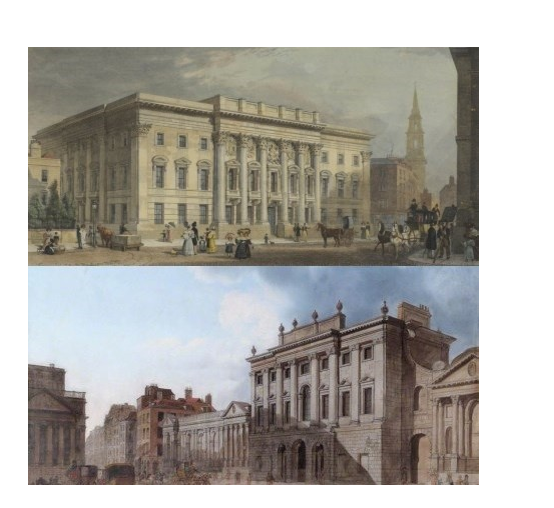History of banking
Earliest Banking Systems
It is impossible to say exactly when banking properly began. We do, however, have evidence that it may have started to properly occur around 8000 BC, although these were not banking in the way that we see things now. It was more record keeping of trades that were being made. There may have been specific institutions developed specifically for banking, but we can’t possibly know for sure. All we have records of are people making trades and record their trades down in a log.

The Earliest ‘Proper’ Banks
The first proper banks would have sprung up in ancient Mesopotamia. We have evidence that there were temples and palaces throughout Babylonia and other cities which provided lending activities. Although, a lot of this was not in the form of financial lending. Instead, banks would lend out seeds and the like. The idea is that by lending out seeds, farmers would have products that they could work with. When it came to the harvest, the farmers would pay back their seed loan from the harvest.
There are also records of credit from around this time. In fact, we have a history of credit and other banking activities throughout Asian civilization. The Temple of Artemis, for example, was a deposit for cash and there were records of debts held here. Mark Anthony plays a major role in these banks. He is said to have stolen cash from these banks.

Banks During the Medieval Period
Banks really started to come into their own during the medieval period. Most of these banks were merchant banks, however. Again, this was a lot about crop loan and for financing expeditions across the silk routes. Some of the earliest forms of brokering took place in these banks.
It is actually from around this time that bankruptcy started to spring up. The earliest banks were in Italy. Bankrupt comes from the word ‘banca rotta’ in Italian. When a trade failed to deliver on their promised route, then they would have been declared ‘banca rotta’.

Modern Banking in the 17th to 19th Centuries
Perhaps the biggest changes to the world of banking came in the 17th to 19th centuries, particularly in London. In fact, the way in which banks work will be based completely around these banking concepts, i.e. issuing bank debt, allowing deposits to be made into banks etc.
The first ‘proper’ bank could be said to be the Goldsmiths of London. It is now a bank, but back then it was more a series of vaults which charged a fee for their services.
People would deposit their precious materials into these vaults, and they would be able to collect them. Over time, Goldsmiths started to provide loans.
The first bank to offer banknotes was the Bank of England. Bank notes were, initially, promissory notes. You would deposit cash into the bank and be offered a note to say that it was there. Over time, the bank started to offer cheques, overdrafts, and traditional banking services. This was important when the Industrial Revolution in the United Kingdom was starting to get into ‘full swing’.

Rothschilds
International financing in the 19th Century took hold due to the Rothschilds. They got started by loaning money to the Bank of England and purchasing stocks. Over time, the Rothchild family (still the richest family in history), started to invest in multiple projects around the world and financing military efforts. They were also taking in deposits from people and creating new banks.

20th Century
It was in the 20th Century when banks started to pop up in the way we know them properly. Post-World War II, banks started to lend money to countries as a whole, and retail banking started to become a proper ‘thing’. In fact, a lot of the technology that was developed throughout the 20th Century is still in use today, e.g. the ATM systems and SWIFT payments.
Evolution of Kenyan banking system
The banking sector in Kenya is ever evolving. Despite the numerous economic challenges that have been witnessed within the sector, the industry remains strong and vibrant. At the moment, three banks have been placed under receivership with only one having recovered and back to operations. Kenya currently has 44 banks. 31 of the banks are locally owned while the remaining 13 are foreign owned. Among the 31 locally owned banks, the government of Kenya has a shareholding in three of them, 27 of them are commercial banks and one is a mortgage finance institution, known as Housing Finance.
When did the banking journey in Kenya start?
The treacherous financial journey in Kenya dates back to the colonial times. The British Empire declared Kenya a British Sphere of Influence and established the East African Protectorate in the year 1865 and officially declared Kenya as a colony in the year 1920. During that 19th Century, the East African region engaged in trading activities and there was need for the use of currency. That was when the revolution in the banking sector kicked off.
In 1986, a year after the establishment of the British Administration in Kenya, National Bank of India came into being. Many people think that the British were the first people to establish banks in the country but the first bank ever in Kenya came from India; National Bank of India.
In 1910, Standard Bank of South Africa came into being. Six years after coming to Kenya, the National Bank of South Africa merged with Anglo-Egyptian Bank Ltd to form Barclays Bank. Barclays Bank was, therefore, born in 1910 as a merger between National Bank of South Africa and Anglo-Egyptian Bank Ltd. In 1951, General Bank of Netherlands was set up. In 1953, Bank of India and Bank of Baroda were set up. In 1956, Habib Bank (overseas) Ltd was set up.
In the year 1955, the Ottoman Bank and the Commercial Bank of Africa were established. Cooperative Bank of Kenya opened its doors in the year 1968. In 1968 National Bank of Kenya took over the Ottoman Bank. In 1971, Kenya Commercial Bank was formed as a result of the merger between National and Grindlays Bank with the governing owning a stake of 60 percent. The Merchant Bank division of Grindlays was merged with Grindlays Bank International Ltd and formed Stanbic Bank. 1971 saw Barclays Bank change its name to Barclays Bank International Ltd while in the year 1974, National Bank of Chicago and City Bank of New York were formed.
The Merchant Bank division was incorporated into a new bank, Grindlays Bank International Ltd, which has changed to Stanbic Bank. In 1971, Barclays Bank (DC) changed its name to Barclays Bank International Ltd and became a wholly owned subsidiary of Barclays Bank Ltd based in Britain. In 1974, the American Banks were established in Kenya i.e. first National Bank of Chicago and first National City Bank of New York.
How long these eleven banks have been in operation in Kenya
Barclays Bank of Kenya has been in operation in Kenya for 97 years, CFC Stanbic Bank has been up and kicking for the last 58 years, Diamond Trust Bank Kenya has been breathing the atmosphere in Kenya for 70 years while Equity Group Holdings Ltd has been in existence for 32 years.
Housing Finance has been in Kenya for 51 years, I&M Holdings for 44 years, Kenya Commercial Bank for 41 years under the brand, National Bank of Kenya for 53 years, NIC Bank of Kenya for 57 years, Standard Chartered Bank for 47 years while Co- operative Bank of Kenya has been into existence for 51 years though it went public as a bank in the year 2008.
